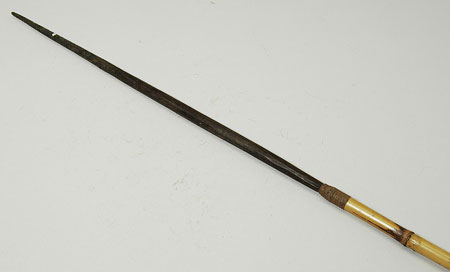Accession Number:
1944.10.42
Country:
Sudan
Region:
Blue Nile Darfung
Cultural Group:
?Burun
Date Made:
By 1912
Materials:
Cane Plant , ?Ebony Wood Plant , Animal Hide Skin
Process:
Carved , Notched , Bound , Incised
Dimensions:
Total L = 1073, L shaft to binding = 733, diam shaft = 9.5, diam arrowhead = 9.3 mm [RTS 6/10/2004].
Weight:
39.1 g
Other Owners:
L. Gorringe and Mrs L. Gorringe
Field Collector:
L. Gorringe
PRM Source:
Mrs L. Gorringe
Acquired:
Donated October 1944
Collected Date:
1902 - 1912
Description:
Arrow consisting of a dark brown wooden point (Pantone 439C), that tapers out from the tip to a long, narrow, round sectioned body, then in again just before its junction with the shaft.
The upper third of the point has been carved with a row of oblique notches on opposite sides - 3 on one side, 4 on the other - and a series of short, deep, horizontal cuts, mostly below the notching.
The remaining surface in this area has been roughened up with a series of more shallow cuts.
The surface has become slightly crazed, which could represent residual surface coating, perhaps poisonous.
The rest of the arrowhead is smooth, with a series of narrow shaving marks visible down its length.
The wood may be ebony, but this needs to be confirmed.
This has been hafted onto a long shaft, made from a length of jointed yellow cane with 6 segments (Pantone 7509C).
The exact method of hafting is not clear, as the junction of arrowhead and shaft is obscured by a narrow strip of brown hide (Pantone 4655C), tightly wound around the body to bind these two elements together, with the lower end of the strip tucked under itself to keep it in place.
There is a second, lighter brown strip just above the base of the shaft, similarly secured (Pantone 466C).
The butt end of the arrow has been nocked, with a deep rectangular slot cut into opposite sides.
The object is complete and intact.
It has a weight of 39.1 grams, and a total length of 1073 mm; the shaft is 733 mm long from its end up to the binding around the base of the arrowhead, with a diameter of 9.5 mm.
The arrowhead has a maximum diameter of 9.3 mm.
Collected by L. Gorringe at some time between 1902 and 1912, possibly from Darfung, and donated to the Pitt Rivers Museum by his wife, Mrs L. Gorringe.
For a group of bows collected by Gorringe, and possibly from the Burun, see 1944.10.28-34; for additional Burun arrows, see 1944.10.34-71.
Currently on display in the Upper Gallery, case 14A.
Rachael Sparks 29/8/2005.
Collected by L. Gorringe at some time between 1902 and 1912, possibly from Darfung, and donated to the Pitt Rivers Museum by his wife, Mrs L. Gorringe.
For a group of bows collected by Gorringe, and possibly from the Burun, see 1944.10.28-34; for additional Burun arrows, see 1944.10.34-71.
Currently on display in the Upper Gallery, case 14A.
Rachael Sparks 29/8/2005.
Primary Documentation:
Accession Book Entry
[p.
375] -
Mrs L.
GORRINGE, Rosaries Farm, Ngong, Kenya
.
Specimens collected by her late husband, Captain L.
Gorringe, M.C., in the ANGLO-EGYPTIAN SUDAN between 1902 and 1912.
Undocumented.
[p.
383] 1944.10.34-71 - [1 of ] Thirty-eight arrows, all of the same type: cane shafts deeply notched, not feathered, the heads ebony spikes tanged into the shaft and tapering to the point.
Above the notch, which is almost immediately below a joint in the cane, and at the opposite end where the head is inserted, the shafts are bound with a narrow strip of thin membrane.
The ebony heads are round in section and varying in length, the extremes being, from above the shaft binding to the tip, 4 1/4" (with long shaft) and 24 5/8" (with short shaft); all are carved towards the tip end, either with an all-over criss-cross pattern more or less shallowly incised, or with two rows of oblique notches cut alternately on the two sides of the point so as to give it a spiral turn.
In a few specimens the shaft is incised in various patterns (owner’s marks?).
Lengths varying between 3' 6 3/4" and 3' 1".
Same data [Probably the BURUN of DAR FUNG].
(In some specimens the tips of the ebony heads are broken or the shaft bindings loose or missing).
Added Accession Book Entry [p. 382] - A21.F16.17-18 [red biro].
Card Catalogue Entry - There is no further information on the object catalogue cards ['Weapons - offensive - Archery - Arrows' RTS 23/7/2004].
Written on object - BURUN, DAR FUNG, A.-E. SUDAN [RTS 6/10/2004].
Added Accession Book Entry [p. 382] - A21.F16.17-18 [red biro].
Card Catalogue Entry - There is no further information on the object catalogue cards ['Weapons - offensive - Archery - Arrows' RTS 23/7/2004].
Written on object - BURUN, DAR FUNG, A.-E. SUDAN [RTS 6/10/2004].




